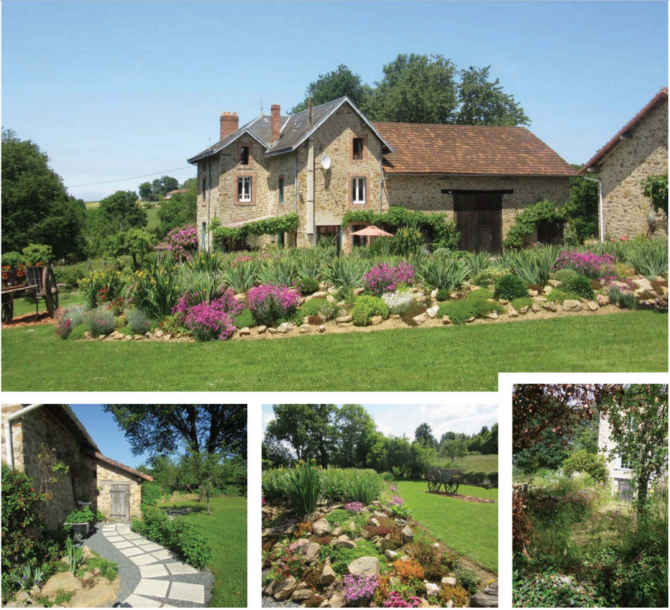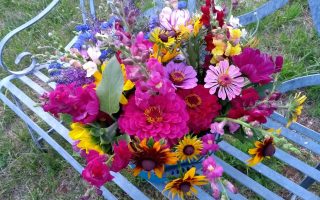The Art of Landscaping – Elements for Garden Design


The Power of Line
Line is one of the most important and useful of all design elements. Everything in the garden involves line. A pathway, drive, or fence is a clear and readily accessible line in the landscape. As you plan and design your garden, always consider the line that is created by whatever you are adding.
There are four main ways to describe lines: Curves, straight, horizontal, and vertical. None is more important than the others – each has different effects.
Curved lines shape informal garden beds and add interest to pathways. Straight lines evoke a sense of order and a crispness that is more formal. Soothing horizontal lines create a sense of stability. Where wide expanse meets the sky, it creates a sense of majestic peacefulness. Vertical lines project a sense of strength and movement. No matter which types of line you use, be aware that lines lead the eye.
Light, Texture and Form
Light
Light and shade change the way colours look and how they work together. Keep in mind that light can be either natural or artificial. It is easy to add a low-voltage lighting system to extend your garden enjoyment into the evening hours. Various fixtures and their positioning create different effects. Front lighting a dark area highlights a particular feature. Backlighting silhouettes a sculpture, tree, or shrub. Side lighting, which can also produce dramatic effects, is used mostly for safety along walks and paths.
Texture
Use texture to contrast plants in groups or minimize architectural lines.
The characteristics of texture divide plants into three basic groups: coarse, medium, and fine. Coarse-textured plants, hardscaping materials, or garden structures have large or boldly tactile components, such as the leaves of rhubarb or a pergola made with brute cut posts. Fine-textured materials include many ferns and grasses or a delicate structure such as a bent-wire trellis or arbor. Medium textures fall in between.
Changes in texture can be subtle; the textures of various plants (and objects) are relative to one another. An ornamental grass, when viewed alone, may seem a fine-textured plant. However, when compared with say, Hare’s-tail grass (Lagurus ovatus), which is much more finely textured, it may appear more coarse-textured.
You’ll find lots of textures – smooth or prickly, rippling or frilly – and endless ways to combine them to achieve repetition, contrast, balance, and unity. All are found in a successful garden.
Form
A Landscape needs strong, contrasting forms. The form and shape of plants and other objects in the garden work to divide space, enclose areas, and provide architectural interest. Grouping plants displays their shapes and creates various effects.
Round forms, such as boxwood or barberry shrubs, for instance, add definition and stability to a mixed border. A series of mounded forms creates an undulating rhythm. Repeated, narrow verticals also add stability. Alone, an upright arborvitae or a thin cactus looks awkward. Clustered, they appear well-placed. The strong uprights of a fence add a sense of security and completeness.
Scale, Pattern and Balance
Scale
Scale, or proportion, is the size relationship of one object to another. A 30-foot tree is out of place in the middle of a small patio, but a dwarf tree makes sense. Conversely, a massive house overpowers a narrow front walk lined with strips of flowers.
Consider the ultimate size of a tree before you plant it. The most beautiful tree in the world will look awkward and out of place if it towers over the front of a house. That same tree, if placed in the back yard, may provide a pleasing frame for the house.
Pattern
Pattern is the repetition of shapes in order. Pattern creates rhythm, as well as charm. It reinforces texture and contrast. When creating patterns, think of light and shadow as part of the palette. Use pattern to draw attention to an area; be careful not to overdo bold patterns, which can overwhelm. Also apply this principle when creating backgrounds. Lay a brick herringbone pattern in walkways, patios, entryways, and driveway borders to unify your hardscape, for example. Employ pattern as a way to direct people through the garden too.
Balance
Visual balance is achieved when the elements on each side of a real or imaginary axis are equal. If too much emphasis is placed on one side of the garden, your eye will be drawn more readily there and not to the garden as a whole.
There are two basic types of balance: symmetrical (formal) and asymmetrical (informal). Formal balance doesn’t always suit a home or garden style. You may prefer informal, or asymmetrical, balance. For example, a large tree on the left can be balanced by three smaller ones on the right. Or a large mass of cool colours (blues, whites and greys) on one side can balance a small mass of hot (red, orange, yellow) colours on the other side.
Accents and focal points serve to make a landscape more interesting. Use them sparingly, however, to maximize their individual impact. Often, a single, interest element added to an otherwise drab scene can make all the difference.
These focal points should stand out from the rest of the garden. Occasional accents, such as an arbour, a sculpture, or a specimen plant, help create balance in a garden between the reference points and the background.
Unity, Contrast and Colour
Unity
Unity results when all of the basic garden design principles come together in a balanced, harmonious whole. Focusing on harmony will help as you choose from an exciting and sometimes bewildering array of plants and other landscaping materials.
Make simplicity a guidepost as well, and you likely will achieve a unified design that gives you a sense of completeness. Good structure in the overall design, combined with hardscape that meets your needs for service and enjoyment, creates the perfect setting into which you can place favourite plants – trees, shrubs, groundcovers, flowers, and seasonal containers.
Contrast
Contrast emphasizes the difference between a plant or an object and its surroundings. Using contrast is the best way to avoid predictability in a garden. It also adds a pleasing sense of tension between elements. Like most garden design principles, in moderation contrast is good, but too much can be confusing and unrelaxing to the eye.
You can contrast textures by varying hardscaping materials, such as bricks and gravel, or plant textures, such as a leathery leaved magnolia next to a finely needled cedar or juniper shrub
The colours of flower blossoms can create wonderful contrasts. To be most effective, the hues should be widely separated on the colour wheel. For example, red and green, purple and orange, and yellow and blue represent the highest contrast in colour. You can also contrast variegated leaves with solid colours, or green and purple.
Colour
Colour seduces the eye, evokes mood, and reflects the seasons. Cool blues, purples, and greens soothe and recede, whereas warm reds, oranges, and yellows enliven a garden.
Single-colour schemes enchant with their simplicity. The real fun comes in expressing your personality by combining colours. Some colours compete for attention; others harmonize.
Although flowers are the jewels of the garden, too many different colours look chaotic. Remember that a balance of subtly different colours creates a pleasing effect.
Rhythm and Variety
Rhythm and repetition come about when you correctly position or contrast features. Rhythm avoids monotony.
Gardens that may be complete in almost every sense may seem ordinary until rhythm is introduced – for instance, a stately procession of shade trees along a drive or the repetition of paves or the pickets in a fence. These elements create a clear sense of movement.
You can combine a variety of plants for compatibility.
Some pairs of plants just seem to grow well together, often because one helps repel pests from the other. Employed by gardeners for centuries, this concept is called companion planting. For example, planting onions or sage near carrots helps repel flies that can infest the carrots. Similarly, radishes planted among cucumbers help ward off cucumber beetles. Garden books can help you find good companions for your favourite plants.
Certain plants are natural botanical bodyguards, protecting just about anything nearby. Marigolds, for example, boast a natural resistance to harmful nematodes and an odour that turns off pests large and small. Other pest-repelling plants include garlic, lovage, and catnip.
You don’t have to take on garden pests by yourself. Nature provides an army of allies in the form of predators that feed on insects. Your friends include birds, bees, wasps, and spiders, as well as beneficial insects such as ladybugs, green lacewings, predator mites, mealybug destroyers, ground beetles, and the wickedly named assassin bug. A birdbath and feeder will attract feathered predators to your garden, while nectar-producing flowers will draw beneficial insects.
These are only the basic guide lines as preached by the likes of the Royal Horticultural Society. Nothing is better than your own on-the-ground experience and trial and error.
•With thanks to Elaine Jarvis
Share to: Facebook Twitter LinkedIn Email
More in garden, guides, people, walking, work
By FrenchEntrée
Leave a reply
Your email address will not be published. Required fields are marked *




REPLY
REPLY
REPLY
REPLY
REPLY
REPLY
REPLY
REPLY
REPLY
REPLY
REPLY
REPLY
REPLY